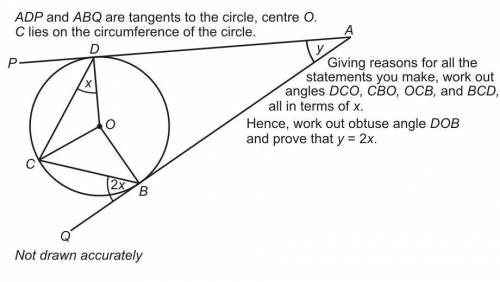
Mathematics, 19.06.2020 16:57 dondre54
That means that DCO and CBO are isosceles triangles. the base angles of isosceles triangles are congruent. So DCO = x. CBO = 90˚ - 2x (the angle where the tangent and the radius of a circle meet is 90˚) CBO is an isosceles triangle (2 sides are radii) Therefore angle CBO = Angle OCB Angle OCB = 90˚ - 2x the sum of a triangle is 180˚ 180 - angle CBO - angle OCB = Angle COB so 180 - (90˚ - 2x)(90˚ - 2x) = 4x Angle COB = 4x DCO is an isosceles triangle therefore DCO = CBO = x the sum of angles in a triangle is 180˚ 180 - angle DCO - angle CDO = angle COD 180˚ - x - x = 180˚ - 2x Angle COD = 180 - 2x Angle BCD = Angle DCO + Angle OCB - x +90˚ - x Angle BCD = 90˚ - x There are 360˚ in a circle, therefore angle DOB - 360˚ - Angle COD - Angle COB = 360-(180˚-2x) - (4x) = 180-2x Angle DOB = 180˚-2x The shape DOBA is a quadrilateral. Angles in a quadrilateral add up to 360˚. Angle ODA and OBA are both 90˚ (But the angle where the tangent and radius of a circle meet is 90˚) Angle DOB = 180 - 2x therefore y = 360 - angle CDA - angle OBA - minus DOB y=360 - (90) - (90) -(180-2x) y=2x


Answers: 2


Other questions on the subject: Mathematics


Mathematics, 21.06.2019 17:30, astultz309459
Apublic library wants to place 4 magazines and 9 books on each display shelf. the expression 4s+9s represents the total number of items that will be displayed on s shelves. simplify the expression
Answers: 2

Mathematics, 22.06.2019 01:30, jude40
Asample of 200 rom computer chips was selected on each of 30 consecutive days, and the number of nonconforming chips on each day was as follows: the data has been given so that it can be copied into r as a vector. non. conforming = c(10, 15, 21, 19, 34, 16, 5, 24, 8, 21, 32, 14, 14, 19, 18, 20, 12, 23, 10, 19, 20, 18, 13, 26, 33, 14, 12, 21, 12, 27) #construct a p chart by using the following code. you will need to enter your values for pbar, lcl and ucl. pbar = lcl = ucl = plot(non. conforming/200, ylim = c(0,.5)) abline(h = pbar, lty = 2) abline(h = lcl, lty = 3) abline(h = ucl, lty = 3)
Answers: 3

Mathematics, 22.06.2019 03:20, rocksac6744
Circle a has center of (2,3) and a radius of 5 and circle b has a center of (1,4) and a radius of 10. what steps will show that circle a is similar to circle b 1) dilate circle a by a scale factor of 2 2) translate circle a using the rule (x+1,y-1) 3) rotate circle a 180 degrees about the center 4) reflect circle a over the y-axis
Answers: 2
You know the right answer?
That means that DCO and CBO are isosceles triangles. the base angles of isosceles triangles are cong...
Questions in other subjects:

Mathematics, 15.12.2020 20:40

Mathematics, 15.12.2020 20:40



English, 15.12.2020 20:40

Chemistry, 15.12.2020 20:40

Chemistry, 15.12.2020 20:40


Mathematics, 15.12.2020 20:40



